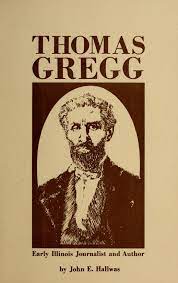Articles/Essays – Volume 18, No. 2
Meet the Author of The Prophet of Palmyra | John E. Hallwas, Thomas Gregg: Early Illinois Journalist and Author
I was anxious to review this biography of the founder of eight nineteenth-century newspapers in and near western Illinois (including the Warsaw Message), the author of The History of Hancock County, and, especially, the author of The Prophet of Palmyra. Just as I started, however, I found a caveat in the first paragraph of the preface: this monograph was written “from a perspective that does not center around the Mormons at Nauvoo.”
That, of course, is a perfectly legitimate perspective from which to write but one disappointing to me and, furthermore, one which again demonstrates that some, for better or worse, become known through what they oppose than what they propose. What I found was a short (98 pp.), good, well-written, useful, and modest account of a man of modest achievements in journal ism, literature, politics, and horticulture in western Illinois for nearly half of the nineteenth century; he died in 1892. This mono graph will be most useful to those involved in Illinois history, and in frontier journal ism. Except where Gregg’s career and activities connect with Mormon developments, however, it will be of little interest to readers of DIALOGUE.
This mini-monograph is well illustrated, extensively documented (175 notes), and presented in a straightforward, narrative style, rather than in an analytical or interpretive manner. There is no bibliography or index; and from the notes, it is apparent that Hallwas made no great effort to use Mormon sources. He cites BYU Studies twice, the Mormon Collection at the Chicago Historical Society six times, the Yale Mormon Papers once, and R. B. Flanders once. When the author goes into a second edition he might also use an 1844 Sarah (Mrs. Thomas) Gregg letter in the Illinois State Historical Library and an 1892 Thomas Gregg letter in the University of Kansas Library.
Now, before I conclude with a review of the book I wish Hallwas, professor of English and director of Regional Collections at Western Illinois University, had written, let me mention what will be of most use to readers of this journal.
Although Hallwas admits that Gregg despised “the whole system of Mormonism” (p. 47), his main line of argument vis-a-vis the Mormons is that Gregg tried to be fair, that he considered Mormons a political rather than a religious problem, and that, as an advocate of procedural democracy, Gregg never suggested violence as a solution. He wrote in 1843, “Let it suffice for the present to say our remedy must be a peaceful one—a remedy that will not inter fere with the Majesty and Supremacy of the Law!” (p. 47) And, in spite of the fact that Gregg could and did write in 1844 that Joseph’s “black heart would exult in carnage and bloodshed, rather than yield one iota of that power he had obtained by his hellish knavery” (Warsaw Message, 10 Jan. 1844), a quote Hallwas understand ably does not use, I think he makes his point.
Many will be interested in the brief account of Gregg’s (1837-39) residence in the abandoned Fort Des Moines at present day Montrose, Iowa, where so many Mor mons, including Brigham Young, lived for awhile after the Missouri expulsion. Curiously, there is no mention of the Mormons at this time. We do, however, learn a bit that is new about the land speculator, Isaac Galland, from whom Joseph Smith bought land in Illinois and Iowa.
During Gregg’s subsequent Warsaw, Illinois, residence we are presented additional insights about the really great Mormon hater, Thomas Sharp, publisher of the rabid, Mormon-baiting Warsaw Signal, at that time the only non-Mormon paper in Hancock County. Gregg contributed a few items to Sharp, the beginning of their association. Later, in 1842, when the Signal temporarily ceased publication, Gregg ac quired the press, launched his Warsaw Message, and continually urged a lawful solution to the problem until Sharp recommenced the Signal two years later.
As an editor and writer Gregg felt compelled for forty years to gather information on and try to explain the “Mormon Conflict.” This collection formed the basis for his jaundiced History of Hancock County and the consistently negative The Prophet of Palmyra. It is Hallwas’s account of Gregg’s various efforts to explain the Mormon conflict which will probably be the most valuable part of this study for Mormon readers.
The small book has yet one more at traction for those who have pored (or may yet pore) over nineteenth-century local newspapers, often in vain, for illuminating facts about Mormon affairs — editors of Gregg’s time and place were little concerned with news and local events, but rather with poems, stories, travel items, editorials, speeches, and, of course, advertising.
I recommend this attractively priced book to all students of the Illinois period of Mormon history.
Thomas Gregg: Early Illinois Journalist and Author by John E. Hallwas (Macomb: Western Illinois University, 1983), 98 pp., $3.95.


 Back to full Issue
Back to full Issue

